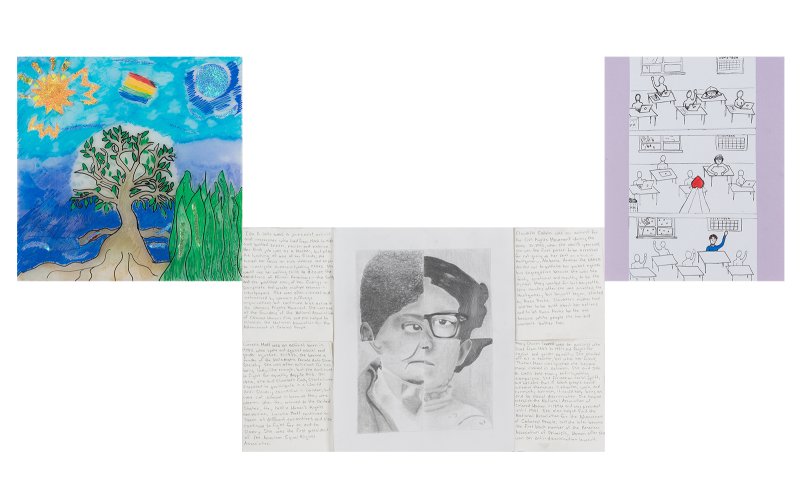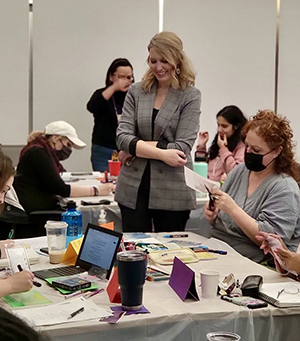An Art Exhibition Reflects Teacher and Student Quests for Educational Justice

ALBANY, N.Y. (May 26, 2022) — Early in 2021, members of the Capital District Writing Project (CDWP), directed by Associate Professor Kelly Wissman of Literacy Teaching & Learning, began exploring ways to be responsive to the racially motivated deaths of Breonna Taylor and George Floyd and the quest to transform inequitable schooling systems. As their meetings progressed, Wissman was drawn to the power of art.
As CDWP director, she had seen the power of writing and of writing in community. Now, she said, “I also felt drawn to the possibility of the arts to help us make sense of the real inequities students and teachers are navigating. I believe that art is both an act of analysis and an act of possibility. It’s also an act of profound hope. Art helps us imagine ourselves and our worlds in new ways.
“I see art as fundamental to our movements for educational justice.”
The result — artworks with profound statements from Capital Region K-12 students and teachers — can be witnessed in the exhibition “Freedom Dreaming for Educational Justice,” on display from June 10-24 in Studio Room 223 in the Fine Arts Building.
The project, made possible through a successful StAR grant application, included a year-long series of monthly Zoom gatherings with K-12 teachers and UAlbany students in the School of Education's Touhey Family Fellows Program. “After some initial hesitation concerning a lack of artistic talent which somehow seems to hit so many after age 6 or so, all our participants found their way into using line, color, paint, cut paper and a range of other materials to express themselves,” said Wissman.

Adults and Children Engage Visions for Education
“It was pretty incredible to see the concentration and joy folks brought to their art-making. The arts gave us another language to express what perhaps we already knew or felt about education, but to say it in a way that gave it a shape and clarity we didn’t have before. It’s been some of the most remarkable and rewarding teaching I’ve done in my time at UAlbany.”
In between the monthly gatherings, the K-12 teachers and the UAlbany students in the Touhey Family Fellows program invited young people in their own contexts to create education freedom dreams. As the students began submitting their pieces for the upcoming exhibition, Wissman said she was “blown away by the creativity, the depth of insight and the great diversity in how students represented their education freedom dreams.”
Some students’ art reflected the marginalization they felt in school and of what they had been missing in their educations. The artworks often reflected the dream of something better. One 10th grader, who created the piece “My Asian American Dream School,” noted she had not read a book by or about an Asian American in all her years of public schooling. 9th grader Chloe Tyson created a montage of Ida B. Wells, Claudette Colvin, Lucretia Mott and Mary Church Terell called “Four Lesser Known Heroes” and wrote she hoped the work would bring people to explore "some historical figures that we don’t usually talk about in the classroom.”
Local Artists Add Guidance
Local artists Marcus Kwame Anderson, Elizabeth Zunon and Alisa Sikelianos-Carter (M.A. ’16) inspired projects in the Freedom Dreaming gatherings. Via Anderson, they created three-panel comics, one panel representing a problem in education needing a solution, the next illustrating the solution, and the third representing a happy ending. Problems that students and teachers have identified in their artwork include the lack of diverse books in the curriculum, the reproduction of the gender binary within school practices, and the need for more attention to social and emotional well-being in K-12 schools.
Sikelianos-Carter inspired participants to create the world each would desire to establish in their teaching and counseling. Several of the results, on plexiglass, Wissman said “are some of my favorite pieces in the upcoming show.”
The exhibition, she said, reflects the educators’ desire “to honor that sense of keeping students at the center of every conversation we have about what education is and what it can be.”
Wissman expressed gratitude to Professor Danny Goodwin and administrative assistant Brooke McGough of Art and Art History “for embracing this project and for offering us the beautiful gallery space in the Fine Arts Building.” She also praised the exhibition design assistance provided by Fatima Hussain and grad students Camryn Walsh and Erik Carrigan.
In writing the StAR grant application in 2021, Wissman saw the opportunity to partner with the Touhey Family Fellows program, an initiative focused on diversifying the teaching and mental health professions. Four local teachers — Amy Salamone from Guilderland High, Christina Pepe from Shenendehowa High, Leah Werther from Niskayuna High and Matt Pinchinat from Guilderland Central School District — worked with Wissman and faculty members Tammy Ellis-Robinson and Cheryl Dozier to design educational experiences associated with the project.




